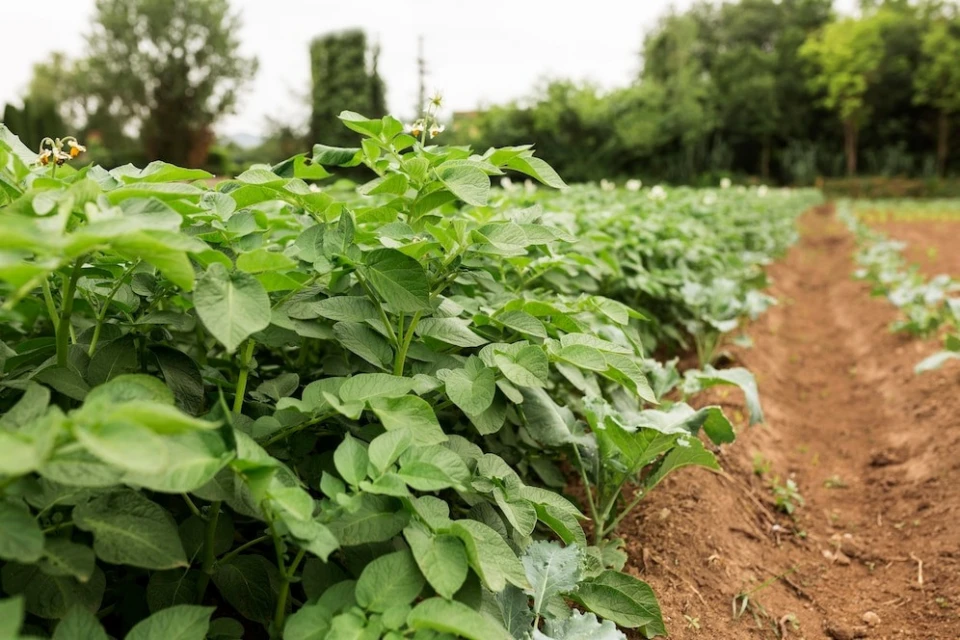Compatibility of vegetables: what is better to plant next to potatoes

Potatoes are a popular vegetable that is often grown by gardeners on their own plots. However, not everyone knows what is best to plant near the bushes of this plant
Potatoes are mostly planted in rows, leaving some space. This practice allows the vegetable to develop properly and receive enough light, water and nutrients. Moreover, the proper use of row spacing and planting of potatoes helps to eradicate weeds and ensure proper ventilation of the plants. About that, writes espreso.tv.
The "neighborhood" of plants also plays an important role in yield and protection of the tuber from diseases and pests. Some crops can have a positive effect on potato growth and immunity by providing pest protection or competing with noxious weeds.
However, it is important to remember that not all plants are mutually beneficial to potato 'neighborhoods'. Some crops can compete for resources or be carriers of diseases and pests, which can negatively affect potato yields. Therefore, it is important to choose the right crops that will grow nearby.
How and when to plant potatoes in 2024?
Potatoes are usually planted in the spring, when the soil is already warm enough, but not yet too dry. The ideal time for planting this plant depends on the climatic conditions of the region, but in general, most farmers and growers use the rule that the soil should be warmed up to +7°C. If the temperature drops below that, the crop will simply freeze and fail to produce a crop. Therefore, many experts warn that the tuber should not be planted in March, as there is a high probability of frost. This can usually be the second half of April or early May. If you have planted potatoes of later varieties, then they can be planted even later, from about mid-May.
Choose a potato variety according to your needs and taste. Early varieties are intended to be consumed immediately after harvesting, they will not be able to be stored for a long time. Mid-season and late-season varieties can be eaten immediately after harvest or stored in the cellar, making them ideal for storage throughout the winter.
Choose a sunny spot for the beds with well-drained soil and develop them by removing weeds and turning the soil. Allow about 60-70 centimeters between the rows so that the plants have enough room to grow. Also, there should be some overgrowth on the vegetable, indicating that it is ready to be planted in the ground. Allow about 60-70 centimeters between the rows so that the plants have enough room to grow. Finish the preparation by placing the tubers in the holes about 10-15 centimeters deep. Bury the holes, leaving a distance of about 30 centimeters between each future bush.
After planting, water the plants regularly (especially during the flowering period), take care of them by removing weeds and protecting them from pests. Choose care methods that suit your needs and capabilities.

Photo: Freepik
What is the best plant to plant between the rows of potatoes?
When choosing plants to share a space with potatoes, it is important to choose those that will be mutually beneficial partners and will not compete for resources. There are several options for plants that can be successfully planted between potato rows.
Legumes
Most plants in the legume family are ideal companions for potatoes because of their ability to enrich the soil with nitrogen and "repel" harmful insects. Bush beans, in particular, are an excellent choice for planting between potato rows, as they will not only provide the right amount of nitrogen and enrich the soil with oxygen, but also won't compete for space with potatoes.
If you decide to plant peas or green beans next to potatoes, then remember not to process the tuber bushes, as this can negatively affect legumes.

Photo: Getty Images
Leafy greens
Leafy greens such as spinach, lettuce, or arugula make great "neighbors" for potatoes because of their short roots, high yields, and ability to provide weed control, retain soil moisture, and improve soil structure.
In addition, these plants will not compete for space with the tuber. Some experts also believe that greens have the ability to "scare away" the Colorado potato beetle. This is especially true for herbs that have a strong aroma, such as mint or basil.
Cabbage and some root vegetables
Potatoes can grow successfully next to cabbage, radish, and other root vegetable crops, provided that the space between them is wide enough to provide each plant with the necessary amount of light and resources.
Cabbage can be a good "neighbor" for potatoes, especially if there is enough space between the rows for both crops. It usually does not compete with potatoes for resources, and its presence can even help protect potatoes from some pests.
Radish can also grow successfully in potato row spacings, especially if it is harvested before the potatoes begin to actively form tops. Its rapid development and early harvest allow you to use the space efficiently.
Mustard is planted in the potato rows as a green manure to enrich the soil with additional nutrients, disinfect it and improve its structure.
Carrots, onions and beets are also great companions for potatoes. These vegetables usually grow at such a level that their fruits do not compete with the root system of the potato. In addition, onions and garlic release phytoncides into the soil, which help protect the tuber from various pests and even diseases, such as late blight.

Photo: Rural Sprout
Corn
Corn is a useful companion for potatoes, as its presence can improve the taste and quality of potatoes, as well as help reduce the risk of disease spread. However, it is important to keep in mind that corn can create a dense shade that will negatively affect potato development, especially during tuber formation. Therefore, growing corn next to potatoes is recommended only if the row spacing is wide enough to provide sufficient light for both crops.
What plants should not be planted between potato rows?
There are some plants that are not recommended for planting between potato rows because they may compete with potatoes for resources, affect their development, or increase the risk of disease and pest spread.
Potatoes belong to the nightshade family. Because plants in this family often share pests and diseases, it is important to avoid planting potatoes near other members of this family. These plants include: eggplants, tomatoes, sweet and hot peppers.

Photo: Experience Life
Planting potatoes next to other nightshades can increase the risk of diseases such as late blight and the spread of pests such as potato weevils. Therefore, to maintain the yield of your potatoes, it is important to maintain the distance between these plants.
Do not plant strawberries and blackberries next to the tuber due to high competition and the possibility of spreading diseases, such as gray rot. The same applies to zucchini and cucumbers, which can transmit late blight to potatoes. In addition, they can grow strongly, take up all the space between the rows and braid the potatoes.
In addition, do not grow crops with deep rhizomes and those that severely deplete the soil, such as sunflower. They can interfere with the development of the root system of potatoes, which is usually closer to the surface of the earth.
Don't be afraid to plant plants in the potato rows, but choose plants with their interactions in mind to maximize the yield and quality of your vegetables.














